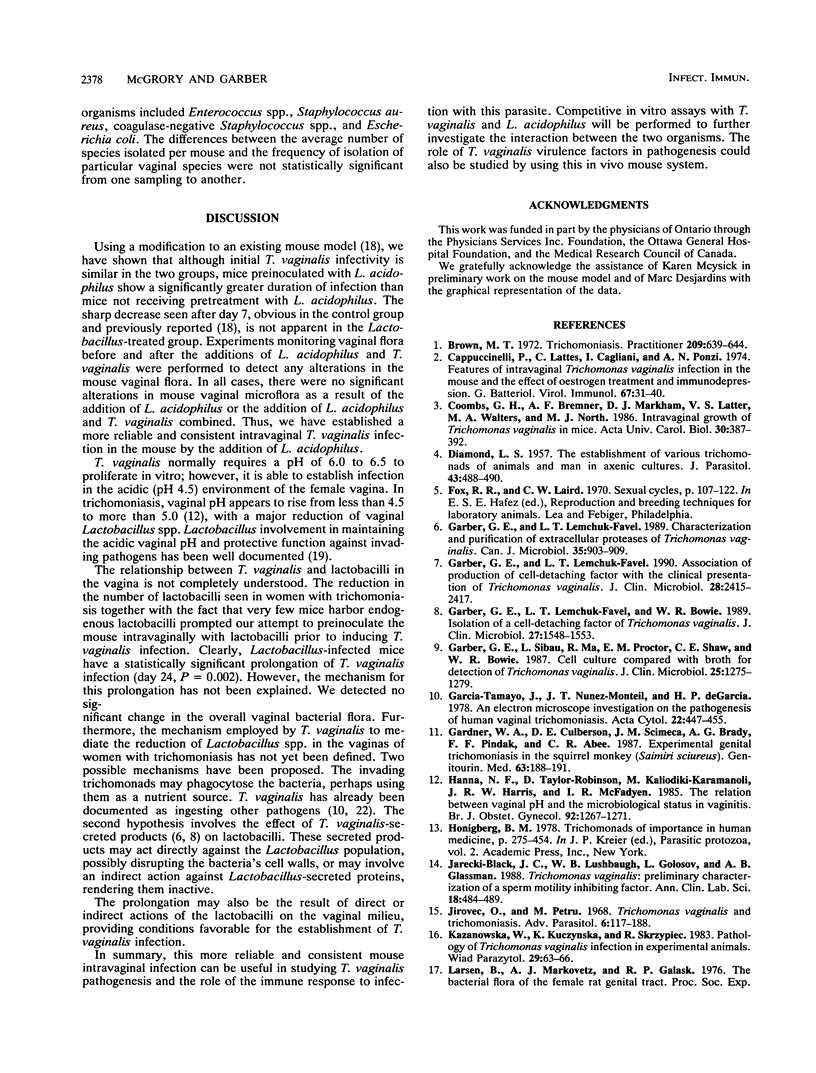Abstract
Recent work with a mouse model of Trichomonas vaginalis infection indicated that only 25% of mice harbor Lactobacillus spp. and that T. vaginalis infection rates fall rapidly after 7 days postinfection. In women infected with T. vaginalis, there is a disruption of the Lactobacillus population, which usually predominates. In an attempt to establish a better mouse intravaginal infection that resembles human disease, we established Lactobacillus acidophilus in estrogenized BALB/c mice. T. vaginalis was then inoculated intravaginally into mice previously infected with L. acidophilus and into mice in an untreated group. From 52 mice, 50-microliters vaginal washes were collected, cultured, and examined daily for live trichomonads after inoculation. Although initial infectivity in the two groups was comparable (79 to 83%), L. acidophilus-infected mice showed greater duration of infection. At day 24 postinfection, 69% of L. acidophilus-infected mice were still infected with T. vaginalis compared with only 11% of untreated mice (P = 0.002). The addition of L. acidophilus did not significantly alter the resident mouse vaginal flora. By the addition of L. acidophilus, the mouse will be valuable for studying factors involved in T. vaginalis infectivity and pathogenicity.
Full text
PDF




Selected References
These references are in PubMed. This may not be the complete list of references from this article.
- Brown M. T. Trichomoniasis. Practitioner. 1972 Nov;209(253):639–644. [PubMed] [Google Scholar]
- Cappuccinelli P., Lattes C., Cagliani I., Negro Ponzi A. Features of intravaginal Trichomonas vaginalis infection in the mouse and the effect of oestrogen treatment and immunodepression. G Batteriol Virol Immunol. 1974 Jan-Jun;67(1-6):31–40. [PubMed] [Google Scholar]
- DIAMOND L. S. The establishment of various trichomonads of animals and man in axenic cultures. J Parasitol. 1957 Aug;43(4):488–490. [PubMed] [Google Scholar]
- Garber G. E., Lemchuk-Favel L. T. Association of production of cell-detaching factor with the clinical presentation of Trichomonas vaginalis. J Clin Microbiol. 1990 Nov;28(11):2415–2417. doi: 10.1128/jcm.28.11.2415-2417.1990. [DOI] [PMC free article] [PubMed] [Google Scholar]
- Garber G. E., Lemchuk-Favel L. T., Bowie W. R. Isolation of a cell-detaching factor of Trichomonas vaginalis. J Clin Microbiol. 1989 Jul;27(7):1548–1553. doi: 10.1128/jcm.27.7.1548-1553.1989. [DOI] [PMC free article] [PubMed] [Google Scholar]
- Garber G. E., Lemchuk-Favel L. T. Characterization and purification of extracellular proteases of Trichomonas vaginalis. Can J Microbiol. 1989 Oct;35(10):903–909. doi: 10.1139/m89-150. [DOI] [PubMed] [Google Scholar]
- Garber G. E., Sibau L., Ma R., Proctor E. M., Shaw C. E., Bowie W. R. Cell culture compared with broth for detection of Trichomonas vaginalis. J Clin Microbiol. 1987 Jul;25(7):1275–1279. doi: 10.1128/jcm.25.7.1275-1279.1987. [DOI] [PMC free article] [PubMed] [Google Scholar]
- Garcia-Tamayo J., Nuñez-Montiel J. T., de Garcia H. P. An electron microscopic investigation on the pathogenesis of human vaginal trichomoniasis. Acta Cytol. 1978 Nov-Dec;22(6):447–455. [PubMed] [Google Scholar]
- Gardner W. A., Culberson D. E., Scimeca J. M., Brady A. G., Pindak F. F., Abee C. R. Experimental genital trichomoniasis in the squirrel monkey (Saimiri sciureus). Genitourin Med. 1987 Jun;63(3):188–191. doi: 10.1136/sti.63.3.188. [DOI] [PMC free article] [PubMed] [Google Scholar]
- Hanna N. F., Taylor-Robinson D., Kalodiki-Karamanoli M., Harris J. R., McFadyen I. R. The relation between vaginal pH and the microbiological status in vaginitis. Br J Obstet Gynaecol. 1985 Dec;92(12):1267–1271. doi: 10.1111/j.1471-0528.1985.tb04874.x. [DOI] [PubMed] [Google Scholar]
- Jarecki-Black J. C., Lushbaugh W. B., Golosov L., Glassman A. B. Trichomonas vaginalis: preliminary characterization of a sperm motility inhibiting factor. Ann Clin Lab Sci. 1988 Nov-Dec;18(6):484–489. [PubMed] [Google Scholar]
- Jírovec O., Petrů M. Trichomonas vaginalis and trichomoniasis. Adv Parasitol. 1968;6:117–188. doi: 10.1016/s0065-308x(08)60473-x. [DOI] [PubMed] [Google Scholar]
- Larsen B., Markovetz A. J., Galask R. P. The bacterial flora of the female rat genital tract. Proc Soc Exp Biol Med. 1976 Mar;151(3):571–574. doi: 10.3181/00379727-151-39261. [DOI] [PubMed] [Google Scholar]
- Meysick K. C., Garber G. E. Interactions between Trichomonas vaginalis and vaginal flora in a mouse model. J Parasitol. 1992 Feb;78(1):157–160. [PubMed] [Google Scholar]
- Redondo-Lopez V., Cook R. L., Sobel J. D. Emerging role of lactobacilli in the control and maintenance of the vaginal bacterial microflora. Rev Infect Dis. 1990 Sep-Oct;12(5):856–872. doi: 10.1093/clinids/12.5.856. [DOI] [PubMed] [Google Scholar]
- Skangalis M., Swenson C. E., Mahoney C. J., O'Leary W. M. The normal microbial flora of the baboon vagina. J Med Primatol. 1979;8(5):289–297. doi: 10.1159/000460213. [DOI] [PubMed] [Google Scholar]
- Street D. A., Taylor-Robinson D., Hetherington C. M. Infection of female squirrel monkeys (Saimiri sciureus) with trichomonas vaginalis as a model of trichomoniasis in women. Br J Vener Dis. 1983 Aug;59(4):249–254. doi: 10.1136/sti.59.4.249. [DOI] [PMC free article] [PubMed] [Google Scholar]
- Street D. A., Wells C., Taylor-Robinson D., Ackers J. P. Interaction between Trichomonas vaginalis and other pathogenic micro-organisms of the human genital tract. Br J Vener Dis. 1984 Feb;60(1):31–38. doi: 10.1136/sti.60.1.31. [DOI] [PMC free article] [PubMed] [Google Scholar]


